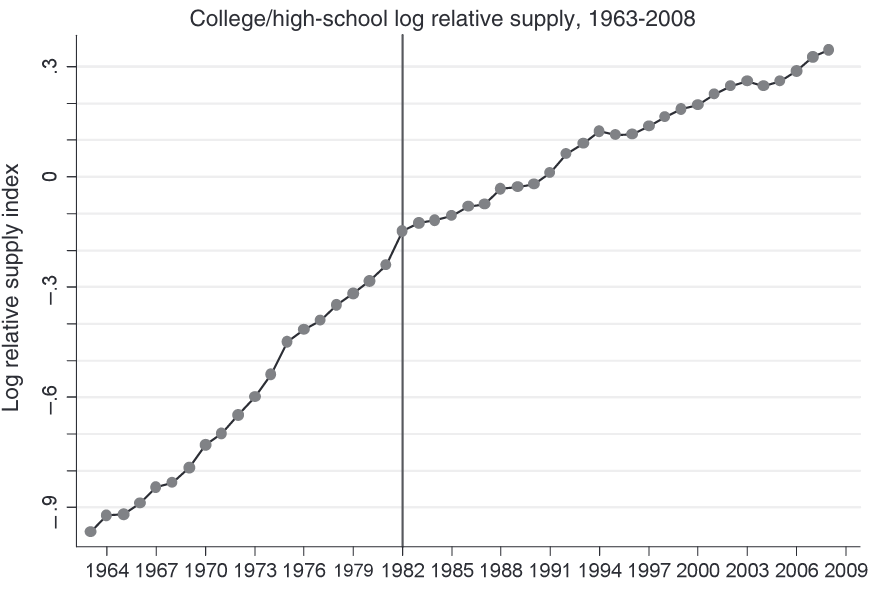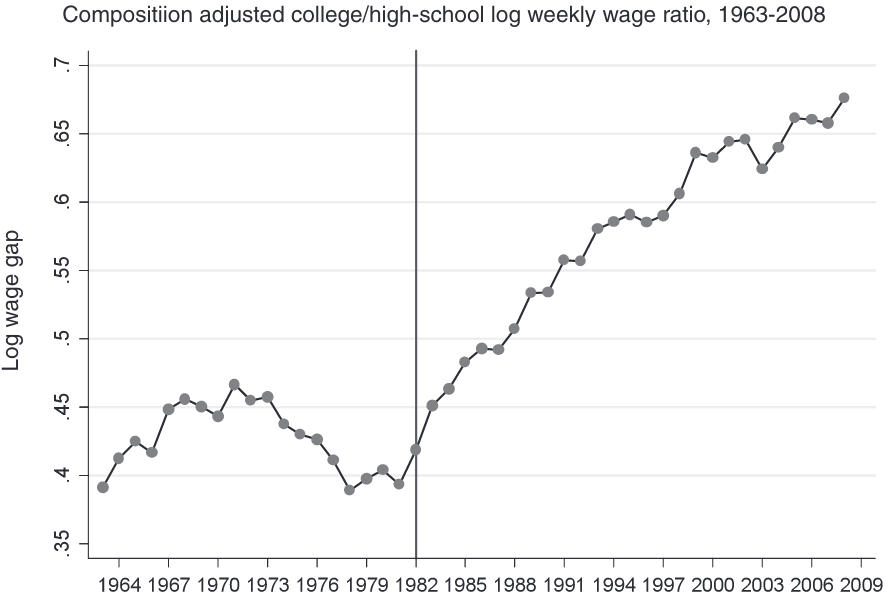
6. Technological shift and labour markets
KAT.TAL.322 Advanced Course in Labour Economics
Labour market of educated workers
Labour supply of educated workers relative to uneducated is on the rise
Standard theory predicts that their wages should go down.
In fact, we see the opposite
Technological change and the labour market
This lecture is based on Acemoglu and Autor (2011)
Canonical model
Canonical model
Overview
Two types of labour: high- and low-skill
Typically, high edu and low edu (can be relaxed)Skill-biased technological change (SBTC)
New technology disproportionatelyHigh- and low-skill are imperfectly substitutable
Typically, CES production function with elasticity of substitutionCompetitive labour market
Canonical model
Production function
Technological changes do not directly replace skills
Whether
Canonical model
Interpretations
- There is only one good and
- There are two goods
- Combination of the two: different sectors produce goods that are imperfect substitutes and
Canonical model
Equilibrium wages
Comparative statics:
Canonical model
Tinbergen’s race in the data
Katz and Murphy (1992)
The log-equation of skill premium is extremely attractive for empirical analysis
Assume a log-linear trend in relative productivities
and plug it into the log skill premium equation:
Tinbergen’s race in the data
Katz and Murphy (1992)
Estimated the skill premium equation using the US data in 1963-87

Implies elasticity of substitution
Agrees with other estimates that place
Tinbergen’s race in the data
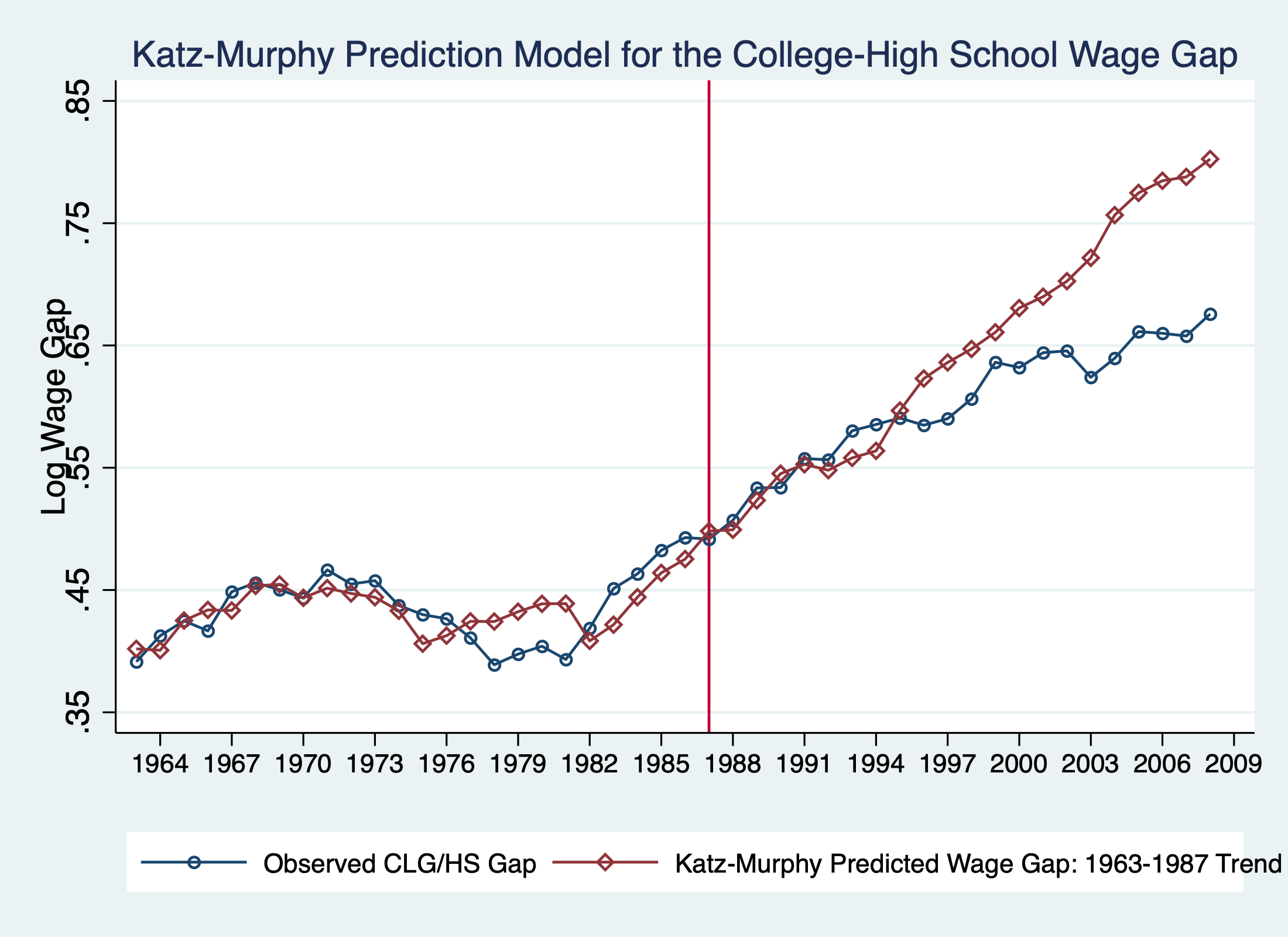
Very close fit up to mid-1990s, diverge later
Fit up to 2008 implies
Accounting for divergence:
non-linear time trend in
bringsdifferentiate labour by age/experience as well
Highlight that slowdown of tech progress in 1990s and 2000s is a very hard sell
Canonical model
Summary
- Simple link between wage structure and technological change
- Attractive explanation for college/no college wage inequality1
- Average wages
However, the model cannot explain other trends observed in the data:
- Falling
- Earnings polarization
- Job polarization
Also silent about endogeneous adoption or labour-replacing technology.
Unexplained trend: falling real wages
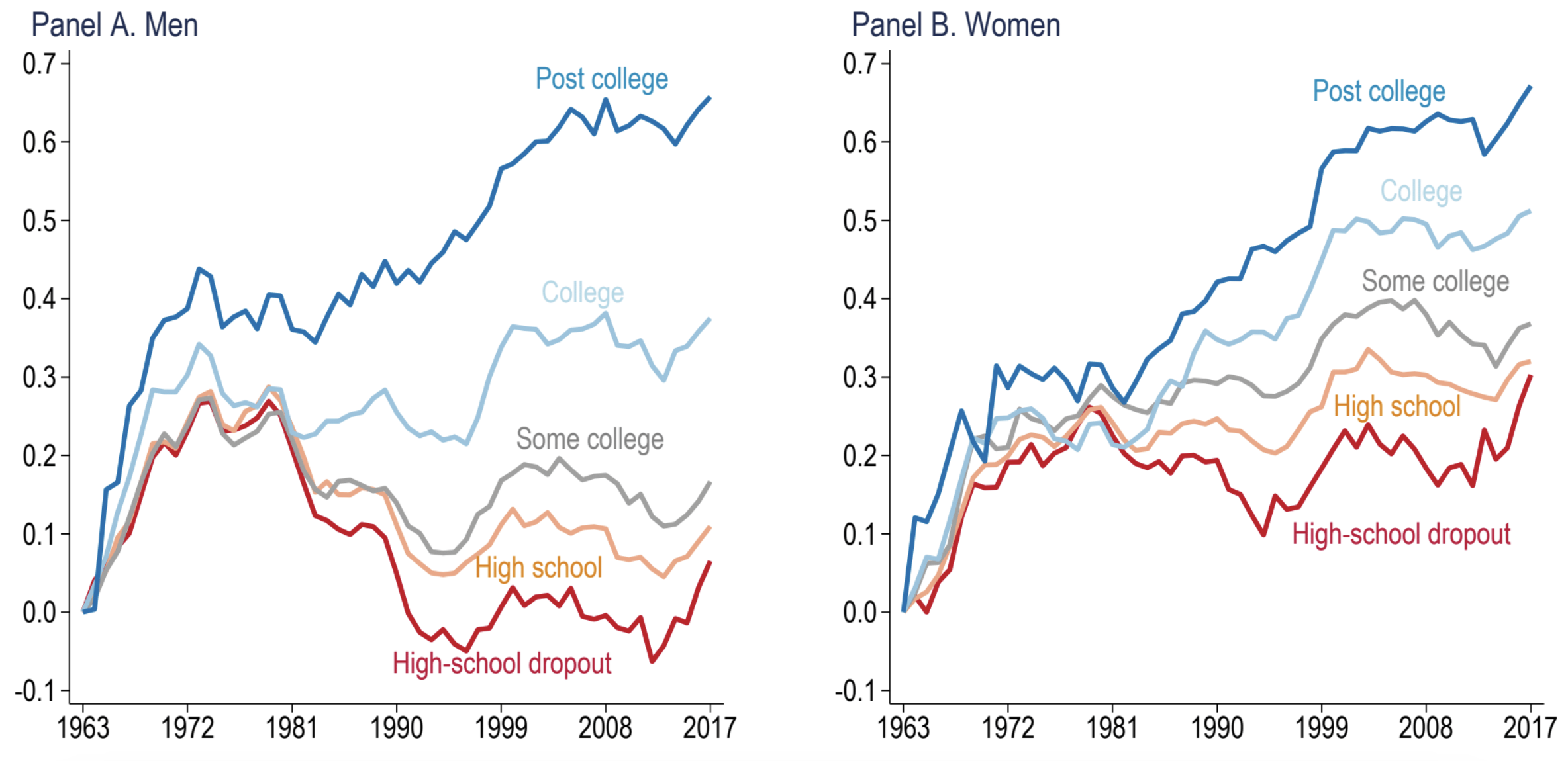
The only way that canonical model can explain falling real wages is if
Unexplained trend: earnings polarization
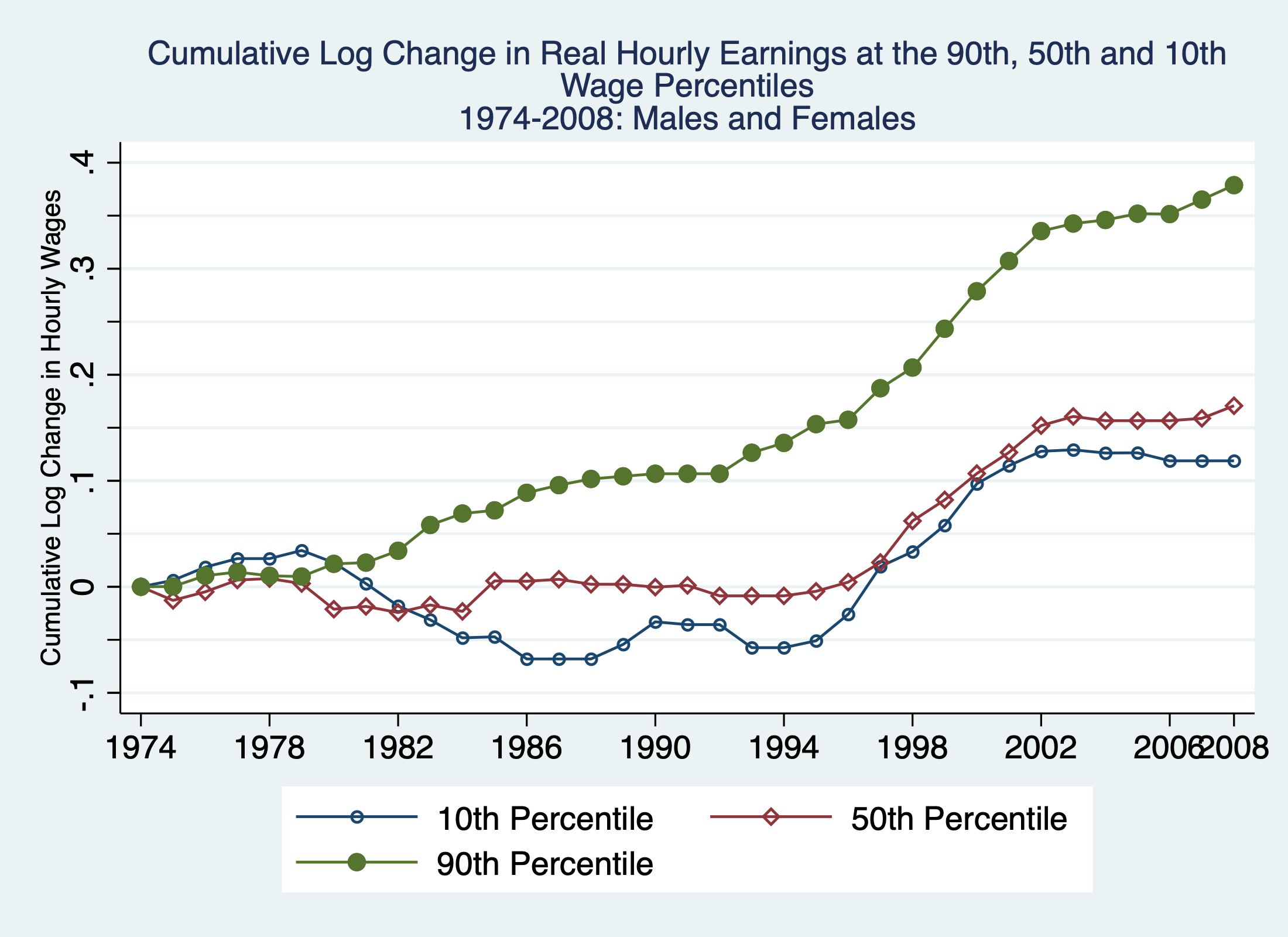
The canonical model can explain between group inequality, like college vs non-college workers
But it suggests that within-group inequality in either group moves 1-to-1 with skill premium.
This graph implies that within-group inequalities moved at their own paces.
Unexplained trend: job polarization
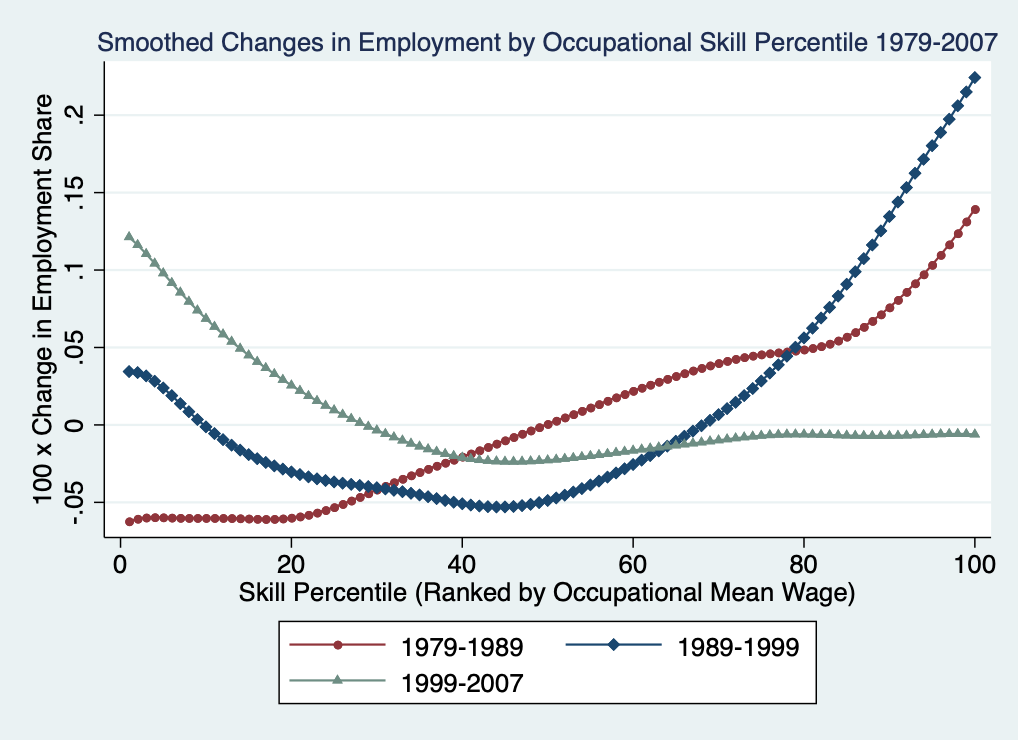
This is just simple, there is absolutely no notion of occupations in the canonical model.
So, no instrument to think about mid-skill mid-job people.
Task-based model
Task-based model
Overview
Task is a unit of work activity that produces output
Skill is a worker’s endowment of capabilities for performing tasks
Key features:
- Tasks can be performed by various inputs (skills, machines)
- Comparative advantage over tasks among workers
- Multiple skill groups
- Consistent with canonical model predictions
Canonical model is a special case: task = skill
Occupations = bundles of tasks
At least 3 skill groups to study earnings polarization
Task-based model
Production function
Unique final good
Three types of labour:
Price of final good is the numeraire
There is now capital in the production function, but no comparative statics about it.
Hence, each task can be produced by
Task-based model
Market clearing conditions
In what follows, we assume machines play no role
Higher task index
Task-based model
Equilibrium without machines
Note that boundaries
This gives rise to the substitution of skills across tasks
Endogenous boundaries means that they will change when
relative supply of skills changes or
technology changes.
Task-based model
Law of one wage
Output price is normalised to 1
All tasks employing a given skill pay corresponding wage
Task-based model
Endogenous thresholds: no arbitrage
Threshold task
Similarly, for
Task-based model
Endogenous thresholds: no arbitrage
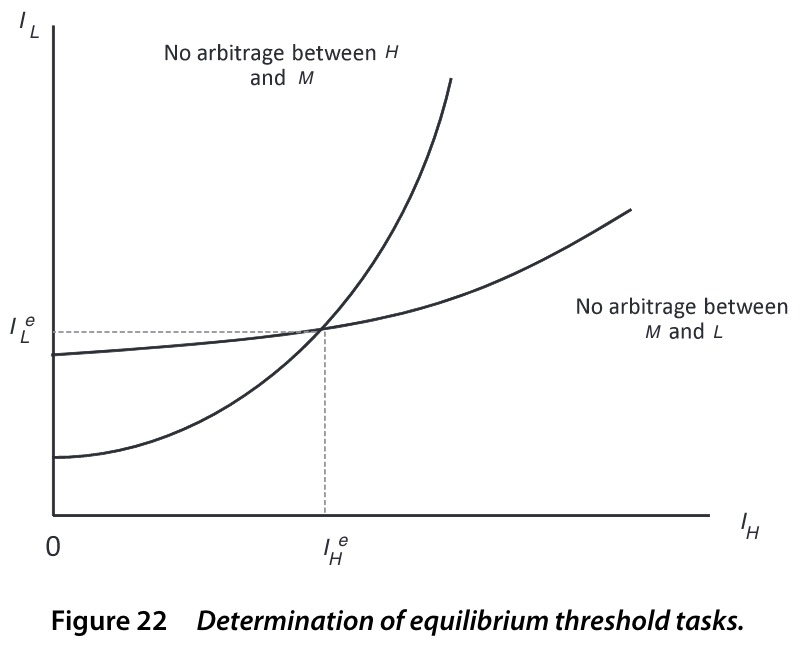
The equilibrium at the intersection because that’s when firm has no incentive to use
Task-based model
Comparative statics: wage elasticities
Consider
- Since supply is constant,
- Depending on comparative advantages:
3a corresponds to when
3b on the contrary is when
When
Unlike canonical model, changes in
Task-based model
Task replacing technologies
Assume in

In this case,
- Machines replace
- Even though thresholds move such that
- Then, displaced
- Whether or not the displacement is heavier on
- Assuming that displacement is larger
Task-based model
Endogenous supply of skills
Each worker
Workers allocate time to each skill given
Assuming that

Comparative statics are more complicated!
But assume that similar to firms pushing
Then, the total effect is even stronger for
However, can’t get nice clean predictions when supply and demand move in different directions.
Task-based model
Illustration in the data
Suppose
Use occupational specialization at some
Descriptive regression informed by the model!
Stress that since
However,
Wages per task can move in opposite direction than wages per skill!
Task-based model
Illustration in the data

Stress again that this is descriptive!
Task-based model
Summary
- A rich model that can accommodate numerous scenarios
- Outsourcing tasks to lower-cost countries
- Endogenous technological change
- Creation of new tasks
- Useful tool to study effect on inequality and job polarization
Empirical results
Acemoglu and Restrepo (2022)
Environment
Multi-sector model with imperfect substitution between production inputs
(exposure to industryattribute 100% of the decline to automation
predict given industry adoption of automation technology
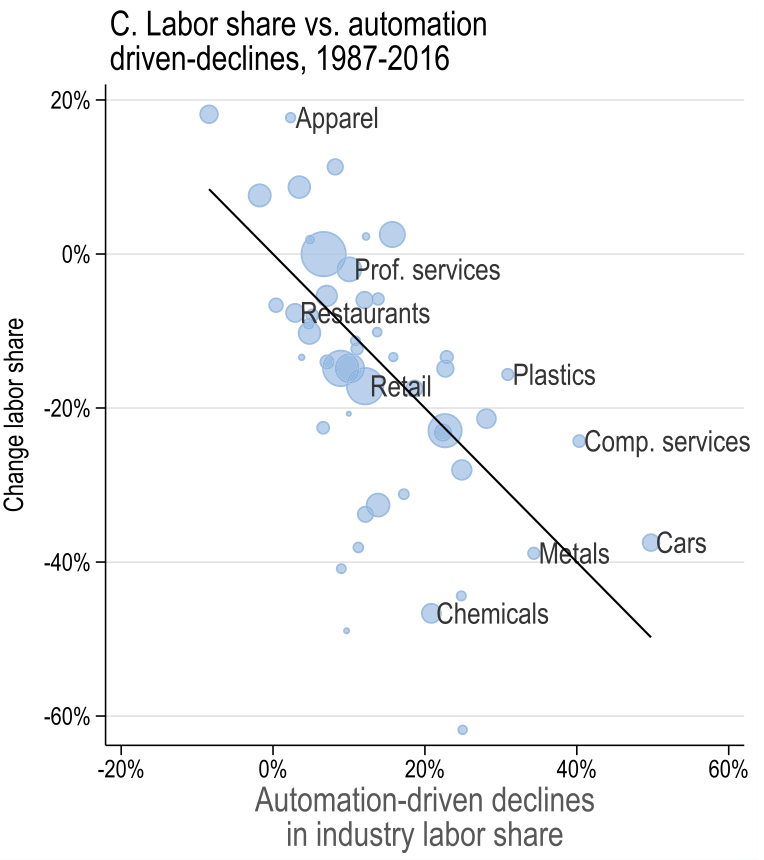
Like in simple exercise, specialization is measured at some
The changes are computed over 1987-2016.
Acemoglu and Restrepo (2022)
Task displacement

- Lower educated groups saw up to 30% decline in their task shares!
- The displacement vs initial wage is inverse-U shaped => most of the displacement happened towards the middle
Acemoglu and Restrepo (2022)
Task displacement and changes in real wages
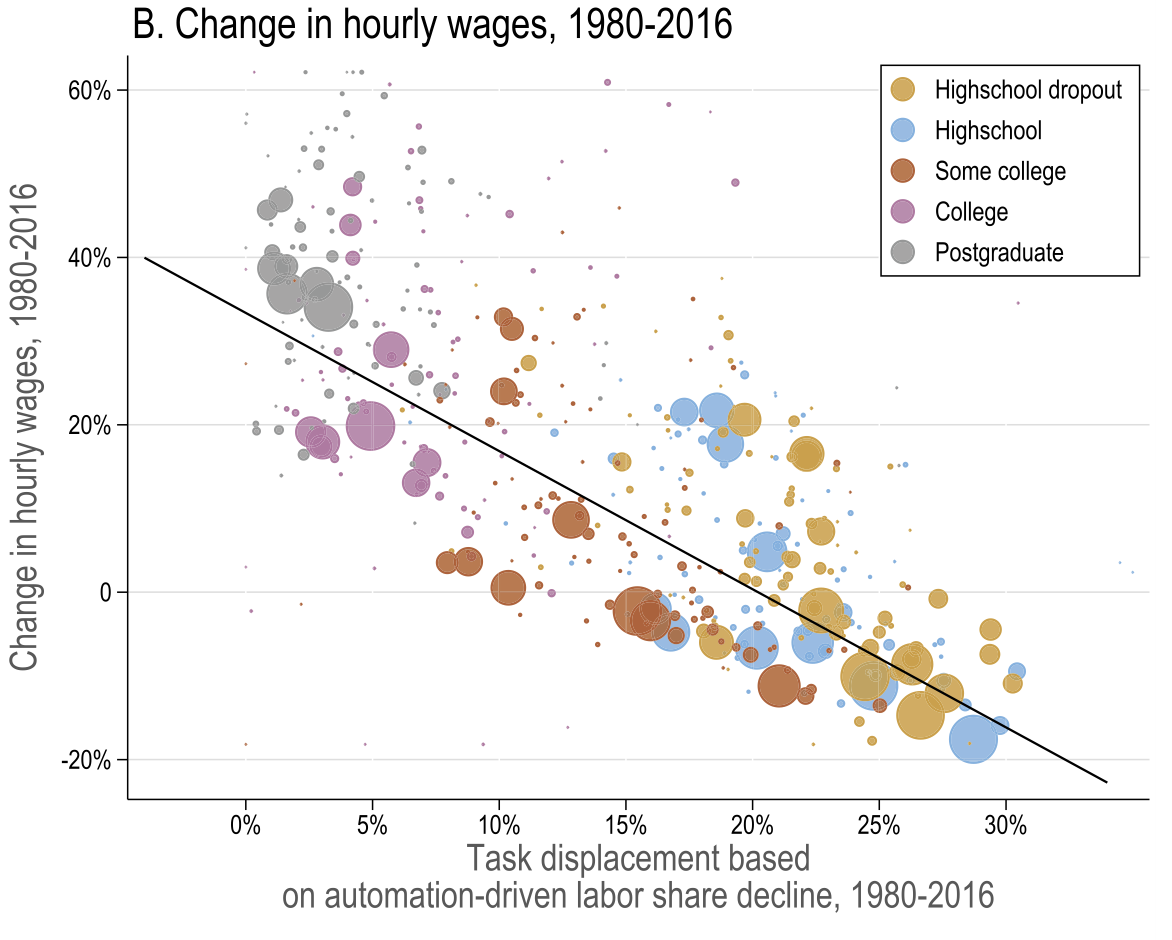
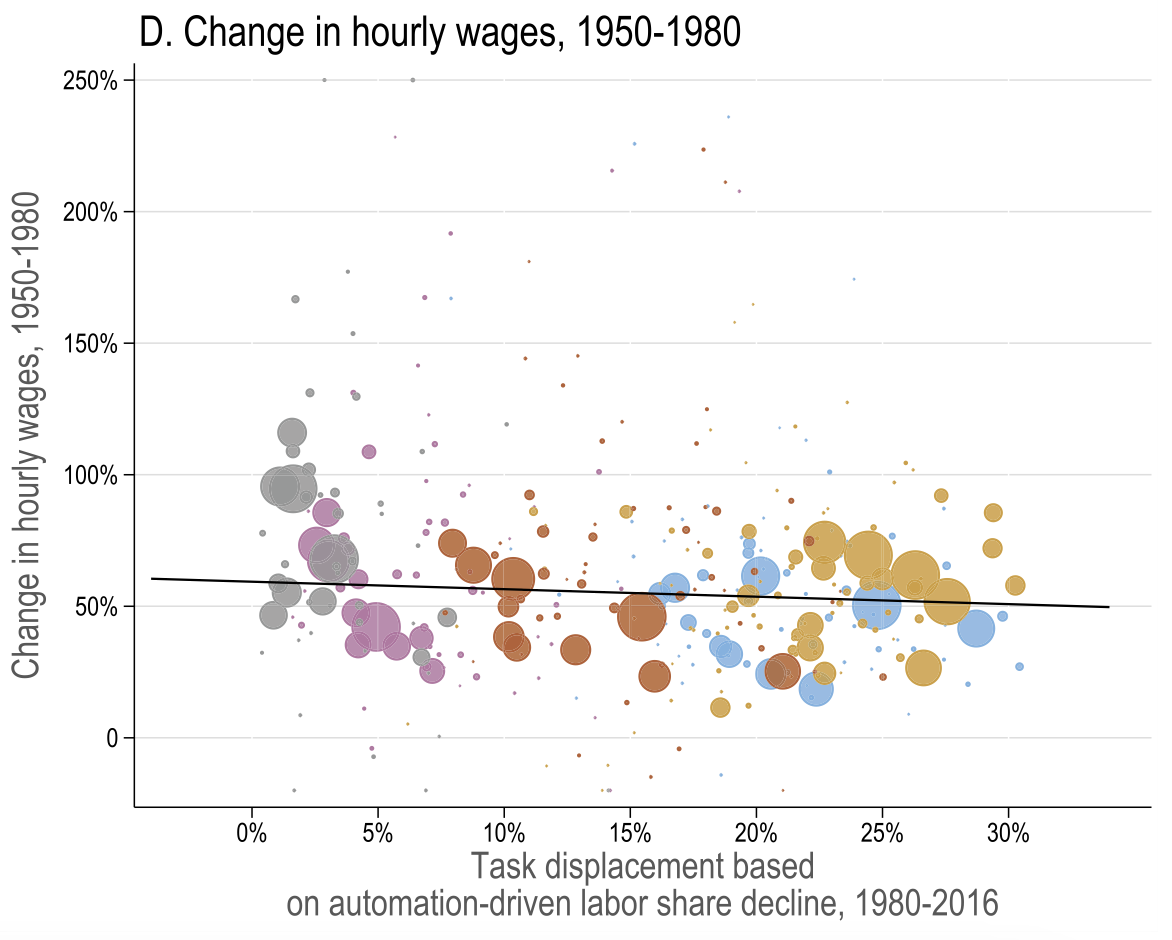
They verify these observations in a series of reduced form regressions. In particular,
50-70% of changes in wage structure are linked to task displacement and to a much smaller extent to offshoring
they conclude that SBTC without task displacement explains less of variation in the data
they ruled out alternative channels like
other non-automation capital
increase in capital use intensity
markups
industry concentration
unionization
and import competition
However, the reduced form estimates ignore general equilibrium. That is, it assumes
there is no endogenous adjustment of task thresholds at other margins (ripple effects)
no change in industry composition
doesn’t take into account productivity gains
Acemoglu and Restrepo (2022)
General equilibrium results
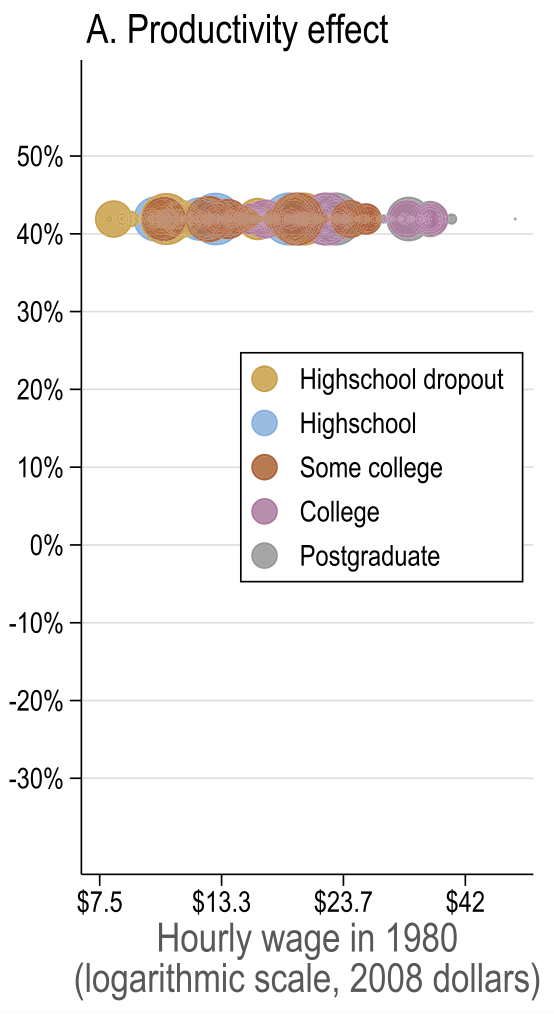
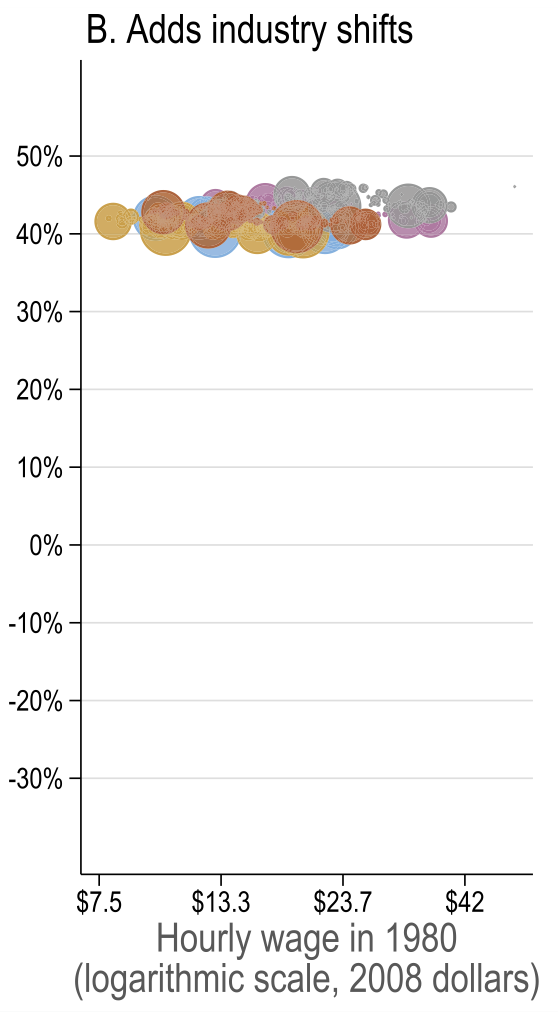
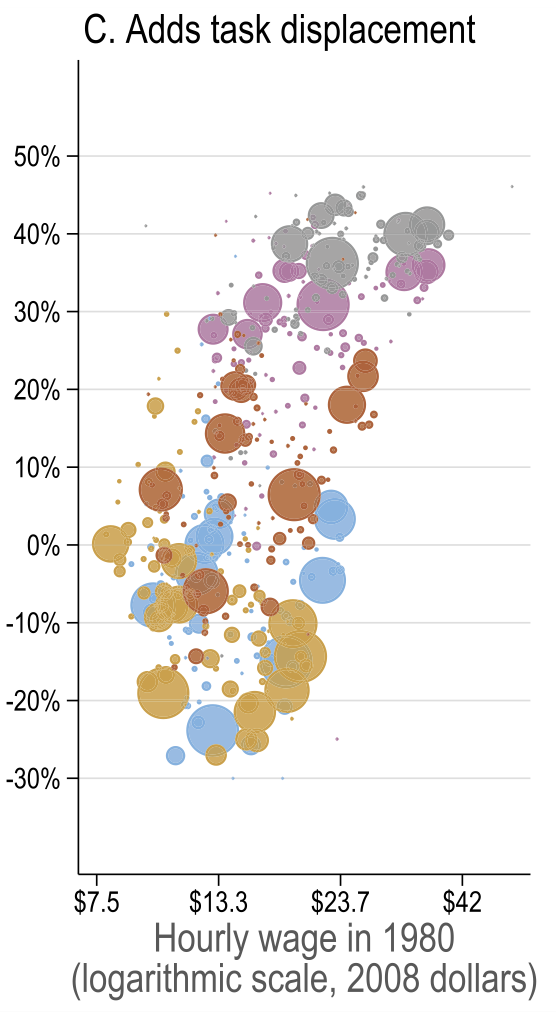
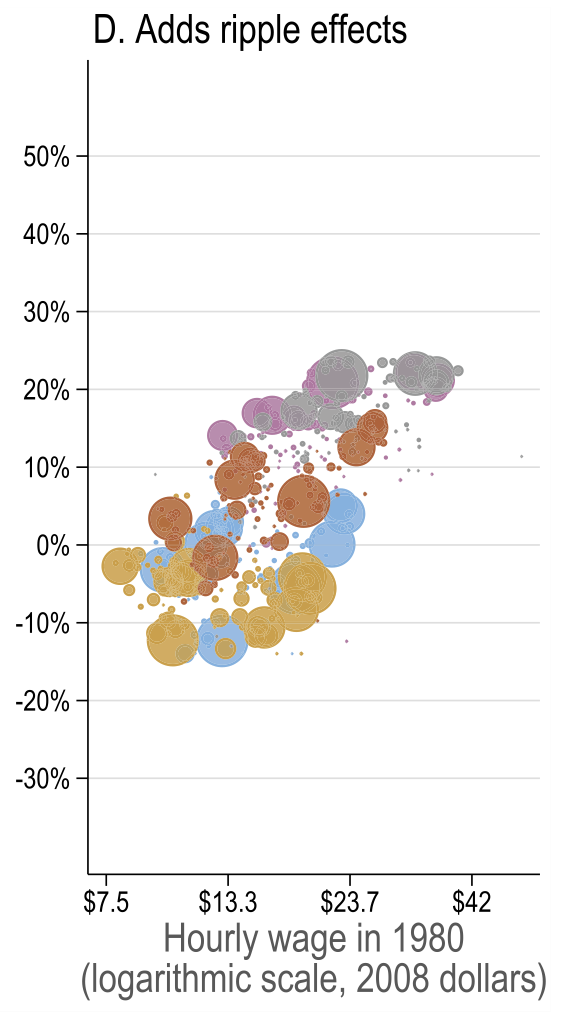
Source: Figure 7
- Common productivity effect
It’s when productivity improvement shifts supply of goods upwards meaning that output of firms goes up and as a result firm’s labour demand goes up as well for all labour categories. - Changes in industry composition induced by automation
Automation induces shift towards sectors with less automation, such as services
Account for <7% of observed changes in US wage structure - Direct task displacement
Explains up to 94% of observed changes in US wage structure, higher than reduced form estimates. The direct effect is larger because it does not allow the displaced workers to compete for tasks in other groups. The reduced form estimate did not control for it, hence it picked up some of the ripple effect. - Allowing for ripple effects
As expected, the magnitudes are lower because displaced workers start performing other group tasks and thus spread the effect across groups.
Acemoglu and Restrepo (2022)
Model fit
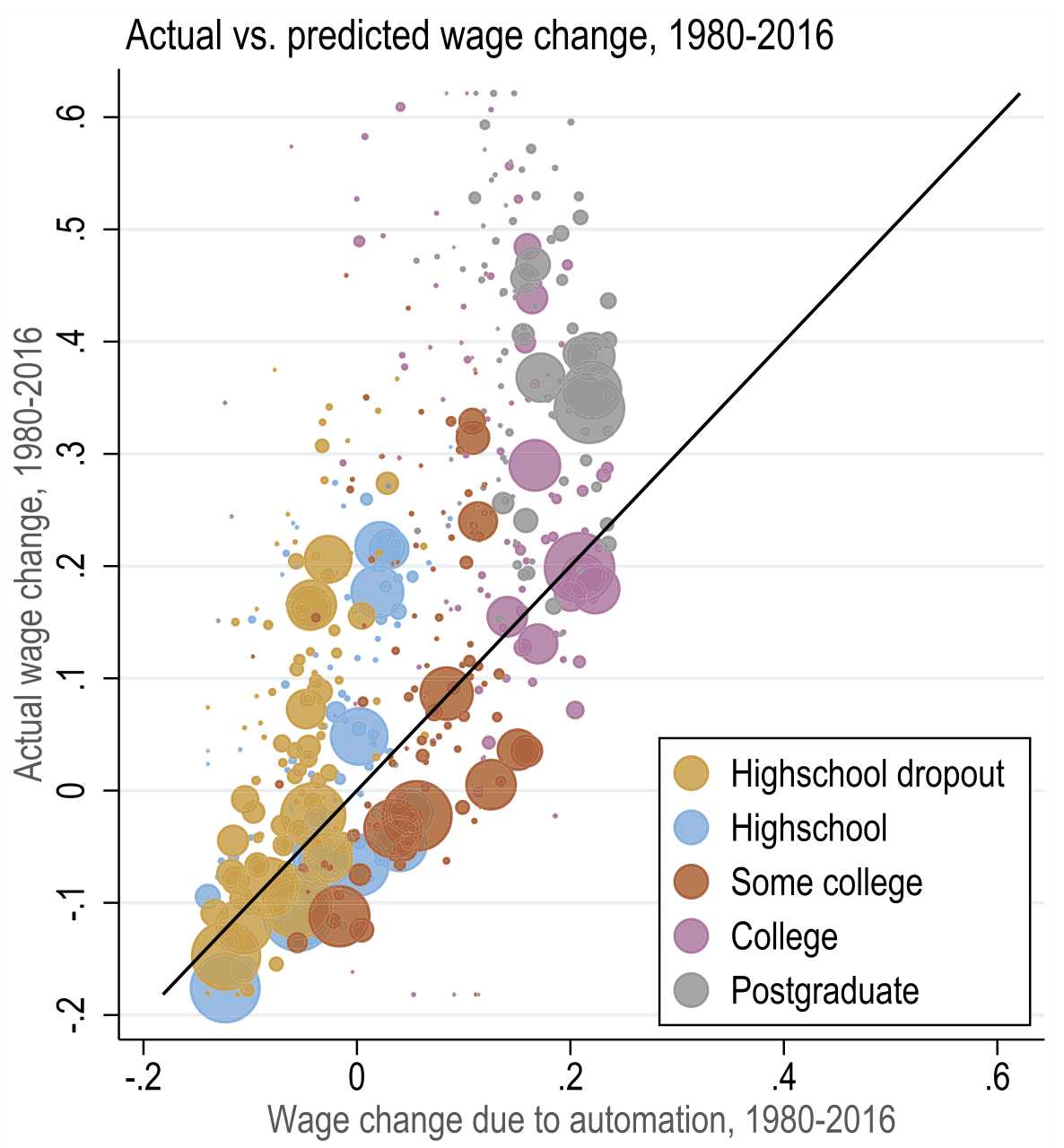
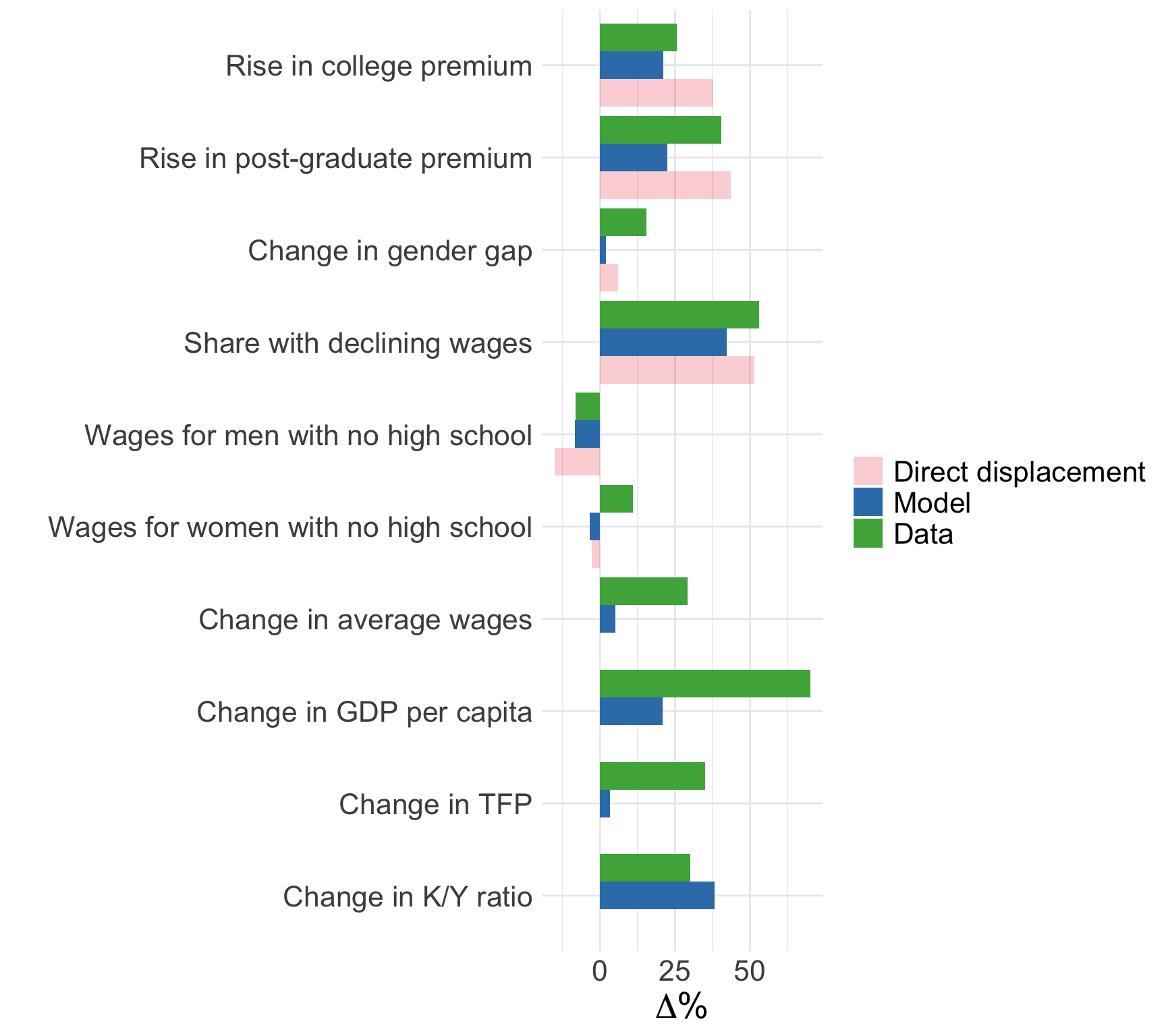
The model has close fit to the data everywhere except top of growth distribution
Technology-labour complementarity at the top
Different kinds of jobs (winner-takes-it-all)
Both absent from the model
It also predicts well changes in college premium and wages of men without high school
But it misses big on aggregate things like GDP and TFP
could indicate there were factor-augmenting tech shifts, productivity deepenings, or even new tasks
this wold affect wage levels, but would have little impact on inequality because have shown that inequality is largely attributed to automation
It also suggests that automation-induced investments in the model are in line with data
It also misses on wages of women, which could suggest that supply side ignored so far can also play an important role.
Summary
Two theories linking technological advancements and labour markets
Canonical model (SBTC)
- Simple application of two-factor labour demand theory
- Empirically attractive characterization of between-group inequality
- Fails to account for within-group inequality, polarization, and displacement
Task-based model (automation)
- Rich model linking skills to tasks to output
- Explains large share of changes in the wage structure since 1980s
Next: Labour market discrimination
Also mention that work continues because
adoption is itself an endogenous decision
creation of new tasks
labour supply adjustments
Appendix: derivation of wage equations
The firm problem is to choose entire schedules
Consider FOC wrt
We normalised
On the next slide, we see that
Similar argument for
Appendix: derivation of skill allocations
Numeraire price (
Therefore, productivity of
If we plug in definition of
Given the wage equations in Law of one wage, we know
Plug it into the market clearing condition for
Similar argument for
